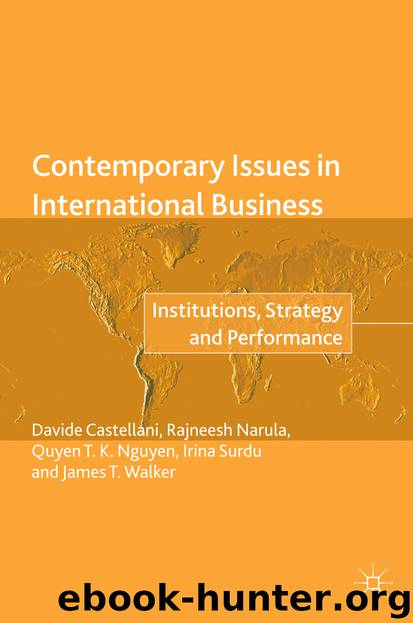Contemporary Issues in International Business by Davide Castellani Rajneesh Narula Quyen T. K. Nguyen Irina Surdu & James T. Walker

Author:Davide Castellani, Rajneesh Narula, Quyen T. K. Nguyen, Irina Surdu & James T. Walker
Language: eng
Format: epub
Publisher: Springer International Publishing, Cham
Developmental Resources and the Strategic Diversity of MNEs
We can now see the broad-brush issue of the effects of MNE participation on the development of host-country economies as a very multifaceted and contingent one. This reflects the endemic pursuit of effective differentiation in both national development through time and strategic diversity of MNEs at a point in time. In the case of national development, our characterisation has suggested that its sustainability needs to move from the early exploitation of readily available standardised inputs towards a more conscious policy-based attempt to generate distinctively differentiated sources of competitiveness to individualise its positioning in the global economy. In international business (IB) terms, this means that at different phases in its development, and to differing degrees, an economy comprises varied LAs with the diverse potential to attract the participation of MNEs.
The relevant characterisation of the MNE here is that of a dynamic differentiated network. At any point in time, a range of differentiated subsidiaries feed into a network of operations that are pursuing a set of diverse strategic objectives, choosing the most appropriate location to achieve each one. This can affect the immediate benefits and developmental potentials secured by a host economy from its LAs. Beyond this, such MNEs are also innately dynamic and provisional. The structure of the network and the positioning of individual subsidiaries in it are always open to adjustment. In accepting that national development, in effect, means changing its LAs we also need to accept that it is always likely to challenge the existing participation and role of in situ MNE subsidiaries. Can they encompass the changing LAs and hopefully enhance their contribution to development? Will they be alienated by them and, perhaps, lessen (or terminate) their participation in ways that compromise the progression of development?
Just as we have seen that primary (level-one) resources may have often provided the starting point for processes of national development, we can also suggest that the related IB strategy of resource seeking (RS) 3 may also have been a prevalent starting point in the historical evolution of MNEs as globally structured enterprises. Thus, business historians have often distinguished RS as the dominant motivation in the wave of FDI in the half-century or so up to 1914. This reflected the growing need to access such resources externally in the home countries of the proto-MNEs, reflecting the needs of high-growth industrialisation. In a similar manner, analyses of China’s recent outward FDI (e.g. Tang & Pearce, 2017) have suggested a key role there for RS to secure increasingly scarce inputs in order to underwrite the sustainability of its current modes of industrial competitiveness . We can now see that these historically diverse contexts nevertheless suggest that RS FDI mediates between the developmental circumstances of two differently positioned economies . One is that of a resource-scarce home country (where it aims to secure prolongation of an in-place developmental process), and the second is that of a resource-rich host (when it may be central to the origins of internationally competitive development).
Download
This site does not store any files on its server. We only index and link to content provided by other sites. Please contact the content providers to delete copyright contents if any and email us, we'll remove relevant links or contents immediately.
The Meaning of the Library by unknow(2485)
Six Billion Shoppers by Porter Erisman(2251)
Why Nations Fail: The Origins of Power, Prosperity, and Poverty by Daron Acemoglu & James Robinson(2215)
No Time to Say Goodbye(2044)
Red Notice by Bill Browder(2006)
The Economist [T6, 22 Thg9 2017] by The Economist(1875)
Currency Trading For Dummies by Brian Dolan(1856)
Thank You for Being Late by Thomas L. Friedman(1721)
Bitcoin: The Ultimate Guide to the World of Bitcoin, Bitcoin Mining, Bitcoin Investing, Blockchain Technology, Cryptocurrency (2nd Edition) by Ikuya Takashima(1653)
Amazon FBA: Amazon FBA Blackbook: Everything You Need To Know to Start Your Amazon Business Empire (Amazon Empire, FBA Mastery) by John Fisher(1522)
Coffee: From Bean to Barista by Robert W. Thurston(1469)
The Future Is Asian by Parag Khanna(1423)
The Great Economists by Linda Yueh(1419)
How Money Got Free: Bitcoin and the Fight for the Future of Finance by Brian Patrick Eha(1372)
Grave New World by Stephen D. King(1368)
Pocket World in Figures 2018 by The Economist(1364)
Capitalism Without Capital: The Rise of the Intangible Economy by Jonathan Haskel(1362)
The Sex Business by Economist(1332)
Cultural Intelligence by David C. Thomas(1252)
